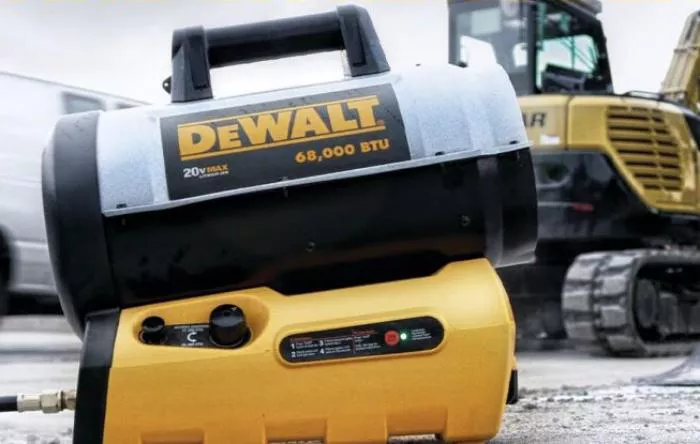Keeping the jobsite warm during the colder months is crucial for both health and safety, as well as for maintaining the integrity of materials and surfaces. Cold stress can lead to serious health issues like trench foot, hypothermia, frostbite, or worse, while ice buildup can create hazards that damage equipment or cause injury. Proper jobsite heating is essential, but choosing between propane and kerosene heaters can be a tough decision. Let’s break down the pros and cons of each and explore best practices for keeping your jobsite warm.
Propane Heaters: Convenience and Reliability
Propane heaters are a popular choice for jobsites due to their ease of use and maintenance. Here’s why:
Advantages of Propane Heaters
Shelf Life: Propane has an indefinite shelf life, so you don’t have to worry about fuel going bad or running foul.
Ease of Maintenance: Propane heaters are simpler to maintain. Ensure the heater is clean and free of leaks (a critical safety step, as propane is odorless and colorless, and high concentrations can lead to asphyxiation).
Portability: Propane tanks are weather-resistant and can be stored outdoors in sun, rain, or snow. However, they can become heavy and bulky, slightly reducing portability.
Safety Features: Many propane heaters come with safety features like tip-over switches and LED lighting for better visibility.
DeWalt Propane Heaters
DXH12B: This personal-sized heater delivers up to 12,000 BTUs of heat per hour and runs for up to 13 hours on a dual-tank setup. It includes three USB charging ports, runs on DeWalt’s 20V Max battery line, and features a tip-over safety switch and an LED strip for illumination.
DXH70C: Designed for larger jobsites, this heater delivers up to 70,000 BTUs per hour. It uses DeWalt’s forced air expulsion system to distribute heat effectively and has a split barrel design for easy maintenance.
Kerosene Heaters: Portability and Cost-Effectiveness
Kerosene heaters are another option, offering unique benefits for certain jobsite needs.
Advantages of Kerosene Heaters
Siphoning Capability: Kerosene has a greater siphoning capability, making kerosene-based heaters like the DeWalt DXH135 easier to transport around the jobsite.
Cost-Effectiveness: Kerosene is often cheaper than propane, especially if you can find it at a nearby pump. However, travel costs for refills may offset savings.
Storage: Kerosene canisters are cheaper than propane tanks but require careful storage in a cool, dry place away from direct sunlight. A shed is ideal, though this may not always be possible.
Challenges of Kerosene Heaters
Smell and Identification: Kerosene has a potent smell and often contains dye for easy identification in case of leaks or spills.
Shelf Life: Kerosene typically lasts 2-5 years before going bad. Additives can extend its shelf life but increase operating costs.
Storage Space: Kerosene canisters take up more space than propane tanks and require careful handling.
Choosing the Right Heater for Your Jobsite
The choice between propane and kerosene depends on several factors:
Weather Conditions: Propane heaters are better for extreme cold, while kerosene heaters may suffice for milder conditions.
Jobsite Size: Larger jobsites may require the high BTU output of propane heaters, while smaller areas can be heated effectively with kerosene heaters.
Portability Needs: If you need to move the heater frequently, kerosene heaters like the DXH135 may be more convenient.
Budget: Kerosene is often cheaper upfront, but propane heaters may save money in the long run due to their ease of use and maintenance.
Determining Heat Requirements
The amount of heat needed depends on several factors:
Weather: Colder climates require more BTUs to maintain a comfortable temperature.
Materials: Certain materials, like metal, can make a jobsite feel colder due to their thermal conductivity.
Jobsite Location: Outdoor jobsites may require more heating than indoor spaces.
Climate Zone: The Köppen-Geiger climate model divides the world into five zones, each requiring different BTUs for heating. For example:
Zone A (Tropical): Minimal heating needed.
Zone B (Arid): Moderate heating required.
Zone C (Temperate): Moderate to high heating needed.
Zone D (Continental): High heating required.
Zone E (Polar): Extensive heating needed.
Best Practices for Jobsite Heating
Ventilation: Ensure proper ventilation to prevent the buildup of harmful gases like carbon monoxide.
Safety Features: Use heaters with safety features like tip-over switches, automatic shutoff, and flameout protection.
Regular Maintenance: Inspect heaters regularly for leaks, damage, or wear and tear.
Heat Distribution: Use fans or forced air systems to distribute heat evenly across the jobsite.
Monitor Temperature: Use thermometers to monitor the temperature and adjust heating as needed.
Conclusion
Propane and kerosene heaters each have their strengths and weaknesses, and the choice depends on your specific jobsite needs. Propane heaters offer convenience and reliability, while kerosene heaters provide portability and cost-effectiveness. By understanding your jobsite’s requirements and following best practices, you can keep your team warm, safe, and productive throughout the colder months.
Related topics:
- The Jobsite – Construction News by Procore
- Construction jobsite falls a rising problem
- Jobsite Editorial – Procore

